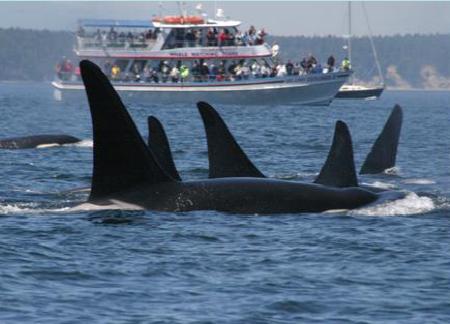美國國家海洋暨大氣管理局(National Oceanic and Atmospheric Administration,NOAA)漁業部(Fisheries Service)西北太平洋區辦事處日前宣佈新的聯邦規章。為保護華盛頓普吉灣定居南方的虎鯨,該規章對來往的船舶與通行加以規範。
擬議中的條例規定船隻必須與虎鯨保持200碼以上的距離,並嚴禁船隻停泊在鯨魚的活動路徑上或進行攔截。
這些大型海洋哺乳動物,又稱為殺手鯨,是皮艇運動愛好者和商業賞鯨團感到極度好奇的對像。並於2005年11月被列入瀕危物種名單。
最後公佈名單前,聯邦部門的海洋科學家確定船隻產生的效應,包括直接干預和噪音的影響,為近來虎鯨數量下降的潛在因素。NOAA漁業部擔心某些賞鯨活動可能會對虎鯨造成騷擾、傷害、或個體和群鯨數量減少等的不良影響。
NOAA漁業部西北區辦事處的代理處長湯姆(Barry Thom)表示,此外,該草案將沿著聖胡安(San Juan)島西側設立一個半英里寬的「禁區」,從5月1日至9月底禁止所有船隻通行。
聯邦漁業部表示,包括純商業捕撈、行駛於既有貨船航道、以及政府和進行學術研究的船隻,將不受該條例的規範。另禁區内也將有限度地允許鄰近的土地擁有者進出其私有房地產。
虎鯨仰賴其精密的聲納導航構造尋找食物。因此容易受到船隻行進時在水下產生的噪音、靠得太近的船隻或阻斷它們活動路徑等因素的影響和困擾。
虎鯨數量於上世紀90年代達到巔峰,計有97頭,隨後在2001年下降到79頭。目前計有85頭。2008年初漁業部公佈其推行的虎鯨復育計劃,旨在呼籲採取行動以減少船隻對鯨魚的干擾。
提案一旦通過,最早將於2010年5月生效。漁業部表示,9月30日將在西雅圖,10月5日在星期五港口分別舉行公開會議,讓民衆深入了解擬議中的條例。該條款的公開評論期於10月27日正式結束。
2004年的一項研究發現,當海洋哺乳動物曝露於人類製造的噪音中,其反應為釋放更多的逆境荷爾蒙,並有可能產生負面作用而影響其神經和免疫系統。
New federal restrictions on vessel traffic aimed at protecting Southern Resident killer whales in Washington's Puget Sound were announced today by the Pacific Northwest regional office of the National Oceanic and Atmospheric Administration Fisheries Service.
The proposed rules would prohibit vessels from approaching any killer whale closer than 200 yards and forbid vessels from intercepting or parking in the path of a whale.
These large marine mammals, also called orcas, are the subject of intense curiosity from kayakers to commercial whale-watching tours, were added to the Endangered Species list in November 2005.
In the final rule announcing the listing, federal marine scientists identified vessel effects, including direct interference and sound, as a potential contributing factor in the recent decline of this population. NOAA Fisheries Service is concerned that some whale watching activities may cause harassment, harm killer whales or cause detrimental individual and population level impacts.
In addition, the proposed regulations would set up a half-mile-wide "no-go zone" along the west side of San Juan Island from May 1 through the end of September where no vessels would be allowed, said Barry Thom, acting head of the NOAA Fisheries Service Northwest regional office.
The federal fisheries agency said there would be exemptions to the rules for some vessels, including those actively fishing commercially, cargo vessels travelling in established shipping lanes, and government and research vessels. The no-go zone would also have limited exceptions for land owners accessing private property adjacent to it.
The whales depend on their highly sophisticated sonar to navigate and find food. They can be affected by underwater noise from boats and disturbed by vessels that approach too close or block their paths.
The population peaked at 97 animals in the 1990s and then declined to 79 in 2001. It currently stands at 85 whales. The agency's recovery plan for this killer whale population, released in early 2008, calls for actions to reduce disturbance from vessels.
If adopted, the earliest the rule would take effect would be May 2010. The agency said it will hold public meetings September 30 in Seattle and October 5 in Friday Harbor for people to learn more about the proposed rules. The public comment period on them closes October 27.
One 2004 study found that marine mammals exposed to human-generated noise released increased stress hormones with the potential to negatively affect their nervous and immune systems.





